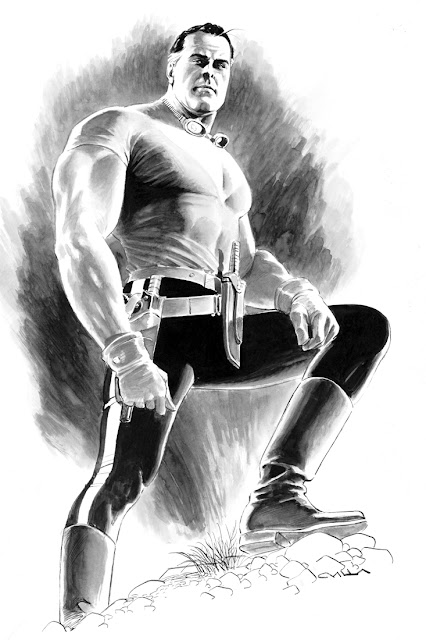CBR: Tell us about the conception of Top Ten [an NYPD Blue-like story about a police department of super-heroes in a city where everyone has supernatural powers.]
Moore: I remember being a kid in the early 60s. And Batman got a computer. He put in facts and got punch type. Mr. Fantastic,
Man from Uncle, all these superheroes got computers. It was part of their super powers. Now everyone has computers. And soon we'll all be hovering, if forecasts are to be believed. Compared to where we were in 1960, we are all super heroes now, and we still can't solve our problems. We still have disasters even though we can sum up more computing power than even Isaac Asimov imagined. That's the appeal of Top 10. It's a fantastic city full of unbelievable people, what a modern urban city feels like.
I was a big fan of
Homicide and
NYPD Blue. And I was thinking about [comics about] superhero groups, why they don't work. But
Steven Bochco seems to be able to handle huge casts of characters very well. So I was thinking it through. Why don't groups work?
Hill Street Blues works. So what if you could have a superhero cop book - at that point the light came on. It can be really funny and you can talk about stuff you cant talk about in super hero books. Like the prejudice against robots. Joe Pi [a police robot] - I'm really pleased with him. It's fun playing against type.
In the next chapter, if there is one, they'll go to Tin Town. The robots are all wearing cogs around their neck. And we have Malcolm Ten as a robot with his own ideas on how machines are treated, and saying to Joe Pie, aren't you selling out your brothers?
What are the obstacles to producing more Top Ten?
Well Jim Lee's Wildstorm was bought by DC. It's always precarious. I don't work in harness, I'm obviously a valuable commodity in the comics world. If I start to feel squeezed, I rise up spitting black blood with snakes coming out of my mouth. I'm potentially explosive. I don't trust em. Anytime something could drop and offend me enough to pull the plug. I won't want to do it forever. But another 12 issues of top 10? You can't stop the thoughts and ideas from occurring. I want to find a way to get them out of my system.
And how about your other super hero title, Tom Strong?
I wanted to do something sweet. It's lazy writing. Something about simplicity which seems to be what people enjoy. Surprisingly, I keep getting these bravery letters for putting in an interracial marriage. There aren't many mixed relations in comics. Since 1939, apart from the X-men, which was ambiguous, it hasn't happened. I hadn't thought about that. How shameful that is. How backward this medium is.
So the other title that seems to be very close to your heart is Promethea [which explores Moore's own fascination with magic and the land where ideas and myths take shape.]
Yes it's a thinly disguised magical rant, that you know you know that just happens to look a bit like a comic book. I'm really enjoying that.












